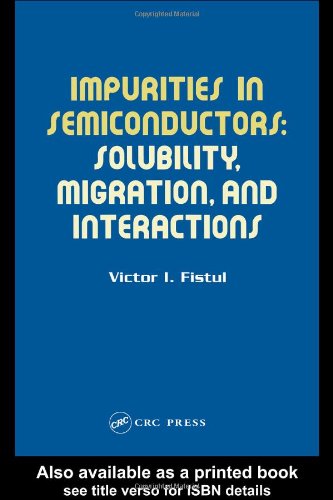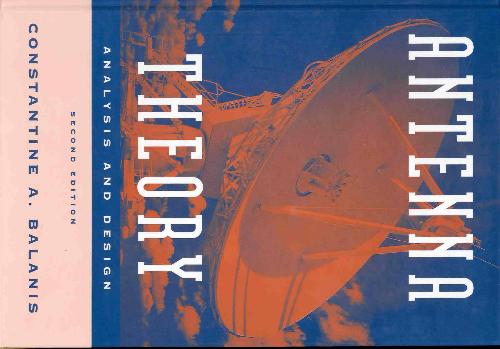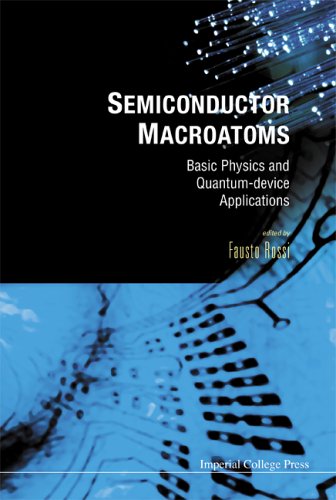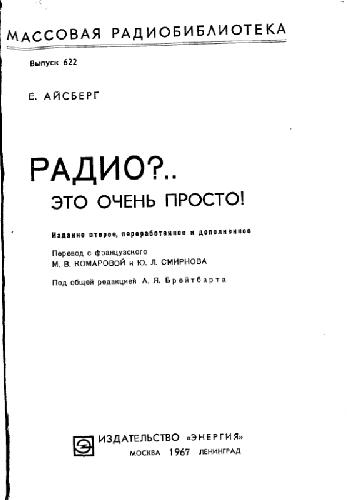Victor I. Fistul9780203167298, 9780203299258, 9780203351406, 9780415308311, 0203167295, 0415308313, 0203299256, 0203351401
Table of contents :
Table of Contents……Page 0
IMPURITIES IN SEMICONDUCTORS: SOLUBILITY, MIGRATION, AND INTERACTIONS……Page 2
Preface……Page 4
Contents……Page 6
1.1 THE SEMICONDUCTOR CRYSTAL AS A THERMODYNAMIC SYSTEM……Page 10
1.2 THERMODYNAMIC DESCRIPTIONS OF IMPURITY SOLUBILITY……Page 18
1.3 GENERAL CHARACTERISTICS OF IMPURITY CENTERS……Page 26
REFERENCES……Page 28
2.1 HYDROGEN-LIKE IMPURITIES……Page 30
2.2 IMPURITIES WITH PARTLY FILLED ELECTRON SHELLS (d- AND f-IMPURITIES)……Page 38
2.3.1 General concepts……Page 58
2.3.2 Carrier thermodynamics in semiconductors with amphoteric impurities……Page 61
2.3.3 Amphoteric impurity distribution in elemental semiconductors……Page 65
2.3.4 Amphoteric impurity distribution in semiconductor compounds……Page 74
2.3.5 Data on amphoteric impurity states and behavior……Page 79
2.3.6 Amphoteric excitons bound by d-impurities……Page 92
2.3.7 Dissociative amphoteric impurities……Page 94
2.3.8 Cation–anion amphoteric impurities in semiconductor compounds……Page 99
2.4.1 General concepts……Page 110
2.4.2 Empirical models of isovalent impurities……Page 117
2.4.3 Physicochemical behavior of the host–IVI system……Page 131
2.4.4 Possible mechanisms of the isovalent impurity effect……Page 132
2.4.5 Isovalent doping effects……Page 135
2.5.1 Hydrogen……Page 143
2.5.2 Oxygen……Page 144
2.5.3 Carbon……Page 154
REFERENCES……Page 155
3.1 RETROGRADE SOLUBILITY OF IMPURITIES……Page 165
3.2 SOLUBILITY OF HYDROGEN-LIKE IMPURITY ATOMS IN GERMANIUM AND SILICON……Page 169
3.3 HYDROGEN-LIKE IMPURITY SOLUBILITY IN AIIIBV COMPOUNDS……Page 176
3.4.1 Solubility in AIV semiconductors……Page 178
3.4.2 Solubility in semiconductor compounds……Page 186
3.5.1 A thermodynamic analysis……Page 187
3.5.2 Solubility of dissociative amphoteric impurities……Page 196
3.5.3 Solubility of cation–anion impurities in semiconductor compounds……Page 202
REFERENCES……Page 203
4.1.1 Site solubility……Page 207
4.1.2 Interstitial solubility……Page 210
4.2 DISSOLUTION ENTHALPY IN THE PSEUDOALLOY MODEL……Page 216
4.3.1 Interstitial d-atom solubility……Page 217
4.3.2 Site solubility of d-atoms……Page 225
4.4 SOLUBILITY OF INTERSTITIAL f-ATOMS IN SILICON……Page 231
4.5 ON SOLUBILITY THEORY FOR SEMICONDUCTOR COMPOUNDS……Page 234
4.6 COMPARISON WITH EXPERIMENTAL DATA……Page 236
4.7.1 Formulation of the quantum chemical problem……Page 239
4.7.3 Quantum chemical calculations of impurity solubility……Page 244
4.7.4 Perspectives of the quantum chemical method……Page 245
REFERENCES……Page 246
6.1 ION PAIRS……Page 249
6.1.2 Ions with a fixed radius……Page 250
6.1.3 Ion pairing manifestation in semiconductor properties……Page 256
6.2 POLYTROPIC IMPURITIES……Page 258
6.3 COMPLEXATION THERMODYNAMICS IN A SEMICONDUCTOR COMPOUND……Page 265
6.4 IMPURITY–VACANCY COMPLEXES IN AIIIBV COMPOUNDS……Page 274
6.5 IMPURITY–VACANCY COMPLEXES IN SILICON……Page 277
6.6 IMPURITY SYNERESIS……Page 278
6.7 COMBINED COMPLEXATION……Page 285
6.8 INDIRECT ION–ION INTERACTION……Page 288
6.9.1 Deep center content versus growth temperature and free electron concentration……Page 290
6.9.2 Homogeneity region width in AIIIBV compounds……Page 292
REFERENCES……Page 296
5.1 TYPES OF IMPURITY INTERACTIONS……Page 299
5.2 STATISTICAL INTERACTION……Page 301
5.2.2 A lattice with several defect types……Page 303
5.2.4 The arrangement of complexes……Page 304
5.2.5 The arrangement of electrons and holes……Page 305
5.3 CHARGE INTERACTION……Page 307
5.4 POTENTIAL INTERACTION……Page 308
5.5 DEFECT INTERACTION IN A REGULAR APPROXIMATION……Page 314
5.6 INTERACTION LEADING TO COMPLEXATION……Page 317
5.7 DEFECT IONIZATION IN SOLIDS……Page 318
REFERENCES……Page 325
7.1 IMPURITY MIGRATION ENERGY……Page 327
7.2 MICROSCOPIC THEORY OF IMPURITY KINETICS……Page 329
7.3 DISSOCIATIVE DIFFUSION OF IMPURITIES……Page 343
7.4 KINETIC EFFECTS IN SUBSURFACE LAYERS……Page 349
7.5.1 General principles……Page 359
7.5.2 Impurity interactions in terms of thermodynamics of irreversible processes……Page 362
7.5.3 Impurity interactions in terms of a model approach……Page 366
7.5.4 Diffusion theory for immobile complexes……Page 370
REFERENCES……Page 374
8.1 DIATOMIC COMPLEXES: FORMATION AND DECOMPOSITION……Page 377
8.2 DIFFUSION MODEL FOR MOBILE COMPLEXES1……Page 383
8.3 SOLUTION OF DIFFUSION EQUATIONS FOR VARIOUS BOUNDARY CONDITIONS……Page 392
8.3.1 Sequential diffusion……Page 393
8.3.2 Simultaneous diffusion……Page 401
8.3.3 Interdiffusion……Page 411
8.3.4 The allowance for the finite front thickness……Page 417
8.3.5 The physics of impurity diffusion with interactions……Page 424
8.4.1 Chemical diffusion of phosphorus into silicon……Page 426
8.4.2 Radiation-stimulated P diffusion into uniformly O2- doped silicon……Page 435
8.4.3 Fe redistribution in B and P diffusion-doped silicon……Page 439
REFERENCES……Page 440







Reviews
There are no reviews yet.